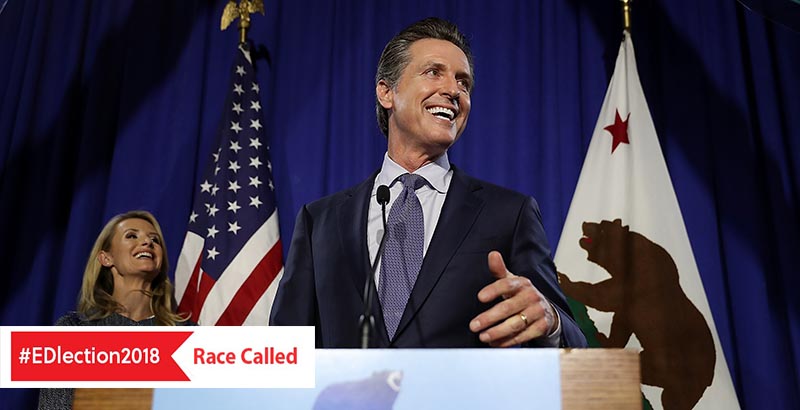EDlection2018: Gavin Newsom Easily Wins Governor’s Race in California, Which He Vows to Make ‘a State of Results and of Refuge’

EDlection2018: This is one of several dozen races we’ve analyzed for the 2018 midterms that could go on to influence state or federal education policy. Get the latest headlines delivered straight to your inbox; sign up for The 74 Newsletter.
Gavin Newsom easily defeated John Cox to become governor of California in a race that in effect was a referendum on President Donald Trump and his policies.
“Too many Californians are priced out of housing, healthcare and higher education. Too many children are growing up in poverty and starting school from behind,” he said in his victory speech Tuesday night.
Newsom, 51, vowed to make California “a state of results and of refuge” and to protect undocumented students known as Dreamers. He has called for universal preschool and increased funding for higher education and pledged to fight Trump administration policies, including those on education.
Near midnight, Newsom had about 59 percent of the vote to 41 percent for Republican businessman Cox.
Turnout was high after voter registration in the state reached an all-time record of more than 19.7 million people; that’s 1.9 million more than in the 2014 midterm elections. On Nov. 2, California’s Secretary of State Alex Padilla reported that an “almost unprecedented” 78 percent of Californians eligible to vote had registered, the largest share in September since the 1996 presidential election, which had 77 percent.
For updated election results follow the Election Liveblog here.
The two candidates both called for improving school accountability and data transparency, as well as attracting and retaining high-quality teachers. But they differ on charter schools: Newsom proposed a moratorium on all new charters, while Cox’s educational vision favored school choice and competition.
“I’ve supported high-quality nonprofit charter schools, but I believe in accountability with taxpayer dollars,” Newsom said in a television interview during his campaign, according to the Sacramento Bee. He supports community schools, which provide basic healthcare and other services to disadvantaged students and their families. But his main educational focus during his campaign was early education and child welfare.
Cox, 63, pledged strong support for charter schools. He also vowed to reduce the power of teachers unions and special interest groups. “I want to put the parents in charge. I want to make it a consumer effort again,” Cox said before June’s primary.
Before entering the gubernatorial race, Cox, an attorney and accountant, ran unsuccessfully for Congress twice in his home state of Illinois and conducted a brief presidential campaign in 2008 that didn’t make it to the primaries. He now lives in San Diego County.
Cox also called for better pay for teachers and basing their salaries and bonuses in part on students’ performance. “I want to see our teachers paid like rock stars and baseball players,” he said while campaigning. He laid out a vision on education aligned with U.S. Secretary of Education Betsy DeVos’s support for school choice by expanding charter schools and homeschooling.
California public schools rank 44th in the nation, based on the national assessment scores for reading and math among 4th and 8th graders. And for the third year in a row, California students’ scores were mostly stagnant on state standardized tests. Only half met standards in reading this year; 39 percent did so in math. High schoolers in 11th grade lost ground, and a stubborn achievement gap persisted between white students and their black and Latino peers. English learners performed at the bottom of all subgroups of students. Over 20 percent of the students in California’s public schools — or 1.3 million children — are English learners.
The disappointing test scores come despite more than $27 billion in extra funding that has gone to schools with large concentrations of disadvantaged students over the last three years through the state’s Local Control Funding Formula.
Newsom had the backing of the powerful California Teachers Association, which also helped him in last spring’s primary to defeat former Los Angeles Mayor Antonio Villaraigosa, an education reformer. Villaraigosa ended up in third place in the June race, which many saw as the demise of education as a significant issue in the governor’s race.
In the only debate between Newsom and Cox, education was barely mentioned, despite poll results released the previous week showing that 9 out of 10 parents who are Latino, black or Asian Pacific Islander said improving K-12 education should be a high priority for the next governor. More than half said it should be an extremely high priority.
In that debate, Cox emphasized that the state’s schools are failing children. “We didn’t talk about education, but the schools are failing our children. That is a future that we are giving up.” Newsom brought up schools as part of his defense of sanctuary cities. “We need to make sure that California leads the way on education, on affordability, on water,” he said. He included prenatal care, early Head Start and preschool in his “most important thing for the next governor.”
Ahead of the primary election, Newsom’s spokesman told the Sacramento Bee that the candidate was a past charter school supporter but had indicated to the CTA while aiming for its endorsement that he was against expanding charters in California “until there is real oversight and stricter enforcement,” the spokesman said.
During his campaign, Newsom highlighted his “California Promise,” a cradle-to-career vision for public education. “Our role begins when babies are still in the womb, and it doesn’t end until we’ve done all we can to prepare them for a quality job and successful career,” he told EdSource after winning the primary. However, he did not address how he would fund that.
Newsom raised three times more money than Cox, at $58.2 million. Cox raised $16.8 million, much of it his own money; the Los Angeles Times reported late last month that $5.7 million came out from his personal bank account.
Newsom is a former San Francisco mayor and served two terms as California’s lieutenant governor. In that role, he also served as a University of California Regent and California State University Trustee. He authored the “Report on the State of Higher Education in California” and introduced the “California College Promise,”a statewide program to increase college access, offering a free first year at community colleges. Gov. Jerry Brown, who is termed out, approved the initiative this year.
As San Francisco’s mayor, Newsom launched preschool and after-school for all students in San Francisco Unified. And he has kept a broad focus on combating poverty in California, which has the largest number of children and the highest percentage of them living in poverty of any other state in the country.
Get stories like these delivered straight to your inbox. Sign up for The 74 Newsletter

;)
